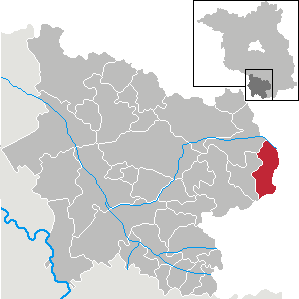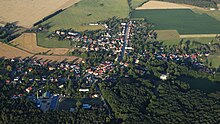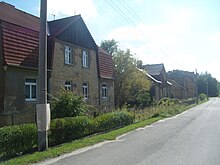Sallgast
| coat of arms | Germany map | |
|---|---|---|

|
Coordinates: 51 ° 35 ' N , 13 ° 51' E |
|
| Basic data | ||
| State : | Brandenburg | |
| County : | Elbe Elster | |
| Office : | Kleine Elster (Niederlausitz) | |
| Height : | 135 m above sea level NHN | |
| Area : | 42.23 km 2 | |
| Residents: | 1428 (Dec. 31, 2019) | |
| Population density : | 34 inhabitants per km 2 | |
| Postal code : | 03238 | |
| Area code : | 035329 | |
| License plate : | EE, FI, LIB | |
| Community key : | 12 0 62 425 | |
| Community structure: | 9 districts | |
| Office administration address: | Turmstrasse 5 03238 Massen-Niederlausitz |
|
| Mayor : | Frank Tischer | |
| Location of the municipality of Sallgast in the Elbe-Elster district | ||
Sallgast ( Załgosć in Lower Sorbian ) is a municipality in the Elbe-Elster district in southern Brandenburg . It belongs to the Kleine Elster (Niederlausitz) office with its seat in the municipality of Massen-Niederlausitz .
geography
Sallgast is located in the original area of the Kleine Elster river, which once comprised 42 springs, in the middle of formerly extensive swamps.
The highest elevation in the municipality is the Galgenberg at 127 m above sea level. NHN near the Weinberg residential area.
The largest cities in the area are Finsterwalde , 14 km to the west, Senftenberg 18 km south-east, Lauchhammer 24 km south and Lübbenau 48 km north. The nearest big city is Cottbus , which is 52 km northeast of Sallgast.
Neighboring communities
Sallgast borders the following communities:
| Surname | border | district |
|---|---|---|
| Bronkow | N | OSL |
| Großräschen | O | OSL |
| Schipkau | SO | OSL |
| Lauchhammer | S. | OSL |
| Lichterfeld-Schacksdorf | W. | EE |
| Mass Lower Lusatia | NW | EE |
Community structure
Districts of the municipality are
Inhabited parts of the community are Henriette , Klingmühl , Poley and Zürchel . Danzigmühle, Luisesiedlung, pond and vineyard are living places .
history
First documentary mention and origin of name
Friedrich Graf von Brehna mentioned the knight Wernerus de Salegast as witnesses in a document dated July 19, 1208, in which he confirmed the donation of the goods in Ockersdorf and Löbersdorf in favor of the St. Peter monastery (near Halle / Saale). Here the name Sallgast appears for the first time in a document.
Like many other knights of his time, Werner von Salegast named himself after his place of residence. There are several interpretations of the place name itself. Possibly it is derived from the Wendish Załgózdz / Za ługom gwózdz ( Lower Sorbian Załgosć), which means something like the dry forest / the hard behind the Lugk (meadow break / grass swamp).
Local history
The history of Sallgast is largely shaped by the history of the moated castle, which later became the palace. For centuries, the life of its inhabitants depended on the favor and economic fate of the manor. The role of the knight Heinz (Heinrich) von Waldow (Waldau) is controversial, who is said to have terrified Lower and Upper Lusatia as a robber baron from here at the beginning of the 15th century . With the von Kottwitz family , a respected aristocratic family took over the possession of the castle and the Sallgast estate for 165 years in 1487. During this time the castle was given its present shape as a four-wing complex.
In the Thirty Years War , Sallgaster Castle, today's Sallgaster Castle, was besieged but not conquered. The entire village, however, was looted and burned down in 1633. The year went down in history as the Croatian year . When the castle could not be taken, the Croatian mercenaries took revenge on the population and burned down their houses. Only the castle and the church remained. In the Seven Years' War , the residents got begged again.
Since the end of the 19th century there has been a change in the economic structure. With the discovery of lignite in the immediate vicinity of the place began a phase of industrialization that lasted several decades. In 1865 the Sallgast teacher Reinhard Salomo registered the first coal mine at Sallgast. He called it the "Gotthold Pit". A few years later (1873/74) the "Sallgast" and "Henriette" mines at Sallgast went into operation. But it was only with the construction of briquette factories and larger open-cast mines "Bismarck I" near Poley and "Bismarck II" near Henriette (1884) that lignite mining began to take on industrial forms. Around 1900 the residential complexes "Kolonie Henriette" and "Kolonie Poley" were built. But as early as 1931 (Bismarck I in Poley) and 1932 (Henriette) this time came to an end with the closure of the coal mines and the associated briquette factories.
In September 1989, a petition was passed to the then State Council of the GDR , which many Sallgasters signed. Among other things, it said in "Input 89": "In this case, we are demanding that the economic yield from lignite mining be seriously weighed against the ecological damage and the social impact." If it was possible to leave a highway out of the open pit, why not a village and a park? The struggle for the existence of the village began and was combined with the struggle for democracy. At the first Sallgaster peace prayer on October 2, 1989, representatives of the district authorities present showed their understanding for the citizens' demands. The press reported extensively on the demonstration on January 27, 1990. On that day, the Sallgaster placed banners and plaques between the village and the edge of the opencast mine to mark the border that the excavator should not cross. June 28, 1990 was of lasting importance for the history of the community: The brown coal combination decided not to excavate Sallgast. The church bells rang for a full hour that day.
Administrative history
Dollenchen, Göllnitz and Sallgast belonged to the Luckau district in the province of Brandenburg since 1816 and to the Finsterwalde district in the GDR district of Cottbus from 1952 . Since 1993, the places have been in the Elbe-Elster district of Brandenburg.
Incorporations
- Henriette (1900)
- Louise Settlement (1921)
- Poley (1928)
- Klingmühl (1930)
- Dollenchen (December 31, 1997) with Zürchel, which was incorporated on May 19, 1974
- Göllnitz (October 26, 2003)
While Henriette and the Louise settlement were built around 1900 and 1921 respectively "on the green meadow", thus the result of the immigration of workers, the other places have their own first mention dates:
- Göllnitz and Dollenchen - 1346
- Zürchel - 1394
- Klingmühl - 1487
- Well Poley - 1550
Population development
|
|
|
|
|
Territory of the respective year, number of inhabitants: as of December 31 (from 1991), from 2011 based on the 2011 census
politics
Community representation
The community council of Sallgast consists of 10 community representatives and the honorary mayor. The local election on May 26, 2019 resulted in the following distribution of seats:
| Party / group of voters | Seats |
|---|---|
| Independent group of voters Sallgast | 3 |
| Alternative free voter community | 2 |
| Göllnitz voter community | 2 |
| Free community of voters | 1 |
| Individual applicant Heiko Lehmann | 1 |
| CDU | 1 |
mayor
- 1998–2003: Rudolf Saath
- since 2003: Frank Tischer (Göllnitz voter community)
Tischer was elected in the mayoral election on May 26, 2019 with 79.8% of the valid votes for a further term of five years.
Sights and culture
The list of architectural monuments in Sallgast and the list of ground monuments in Sallgast contain the cultural monuments entered in the list of monuments of the State of Brandenburg.
Buildings
Sallgast Castle and Castle Park
→ See also the main article Schloss Sallgast
After the von Rohr family (1652 to 1714), it was the family of the Prussian Kommerzienrat von Jampert (1744 to 1775) who had further structural changes made to the castle. There were ten changes of ownership over the next hundred years. In 1878 Robert von Loebenstein acquired the Sallgaster manor . He had the park laid out in its current form. From 1911 to 1914 the property went to the Berlin banker and councilor Max Abel, who had a representative summer residence designed. Johannes Schwartz from Berlin, who bought the property in 1917, had the same intentions. The BUBIAG , a brown coal mining company , set up in the castle from 1939, a maternal and child convalescent home one, the 1946 with the nationalization of the company in public ownership passed.
In 1993 the castle was acquired by the municipality of Sallgast. There was a restaurant there from 1966 until the end of 2011. Several attempts to continue has failed so far. There is a wedding room of the registry office, the local history museum and several guest suites.
Churches
The church in Dollenchen was built around 1300 and is a stone block construction. The west transverse tower with a baroque dome was completed in 1698. Inside the church there is also a pulpit altar from the 18th century and a late Gothic font from the beginning of the 15th century.
There is an early Gothic church in Göllnitz. It was built at the end of the 13th century and completely renovated and restored in 1993. Particularly noteworthy are the wooden sculptures that have recently been back on their wall plinths: Madonna of the moon , Jesus on the cross, Saint Sebastian and Peter . Next to it is the restored Schröther organ with its bright, clear sound from the 19th century. There are regular concerts in the style of gospel , jazz and classical music to Latin American music.
Museums
- Dollenchen local history and mill museum
- Local history museum in Sallgast Castle
Wildlife enclosure Göllnitz
There is a large fallow deer enclosure in Göllnitz. Here the animals can be observed at close range in the herd.
Regular events
The Park Festival in Sallgast (end of June) and the traditional Stollen Riding Festival in the Dollenchen district (mid-July) take place every summer.
Economy and Infrastructure
traffic
Road traffic
In the middle of the municipality of Sallgast, past the districts of Dollenchen and Zürchel, the B 96 federal road runs between Finsterwalde and Senftenberg . The A 13 Dresden - Berlin runs 6 km east of the community. It can be reached via the Großräschen junction .
Rail transport
The Sallgast station was on the Finsterwalder-Schipkauer Railway . In 1967 passenger traffic on this route was stopped.
Local public transport
Local public transport is served by buses from VerkehrsManagement Elbe-Elster GmbH from Finsterwalde.
education
Sallgast has a primary school from the 1st to the 6th grade as well as a kindergarten. There is a kindergarten in the Göllnitz district and a private daycare center in Dollenchen.
The former kindergarten in Henriette, which previously housed a primary school and subsequently the village cinema, has now been converted into a residential building.
Sports
The club SV Rot-Weiß Sallgast was initially founded as a table tennis club in 1964. Since 1993 there is under the name FC Rot-Weiß Sallgast '64 e. V. a football club in the community. Another club is the shooting society "Kleine Elster" founded in January 1995.
Personalities
- August Pohlenz (1790–1843), composer and conductor, born in Sallgast
Web links
- Link catalog on the topic of Sallgast at curlie.org (formerly DMOZ )
- Contribution to the RBB program Landschleicher on May 18, 2008
Individual evidence
- ↑ Population in the State of Brandenburg according to municipalities, offices and municipalities not subject to official registration on December 31, 2019 (XLSX file; 223 KB) (updated official population figures) ( help on this ).
- ^ Service portal of the state administration Brandenburg. Sallgast municipality
- ↑ Serbske Korta WOT Jana Ernsta Smolerja abo Jan Arnost Smoler, 1845th
- ^ StBA: Changes in the municipalities, see 1997
- ↑ Municipalities in 1994 and their changes since January 1st, 1948 in the new federal states . Federal Office of Statistics. Metzler-Poeschel publishing house, Stuttgart, 1995, ISBN 3-8246-0321-7 .
- ↑ Changes in the municipalities in Germany, see 2003. Federal Statistical Office.
- ↑ Historical municipality register of the state of Brandenburg 1875 to 2005. Elbe-Elster district . Pp. 22-25
- ↑ Population in the state of Brandenburg from 1991 to 2015 according to independent cities, districts and municipalities , Table 7
- ^ Office for Statistics Berlin-Brandenburg (Ed.): Statistical report AI 7, A II 3, A III 3. Population development and population status in the state of Brandenburg (respective editions of the month of December)
- ^ Result of the local election on May 26, 2019
- ↑ Results of the municipal elections in 1998 (mayoral elections) for the Elbe-Elster district ( Memento of the original from April 21, 2018 in the Internet Archive ) Info: The archive link was inserted automatically and not yet checked. Please check the original and archive link according to the instructions and then remove this notice.
- ↑ Local elections October 26, 2003. Mayoral elections , p. 24
- ↑ Section 73 of the Brandenburg Local Election Act
- ^ Result of the mayoral election on May 26, 2019





